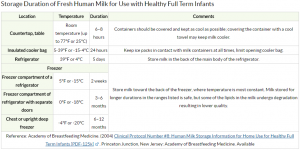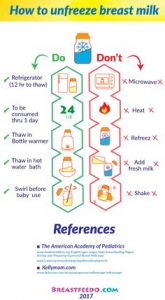
- Breast milk is the ideal food for infants and young child.
- It should be done for at least 1st two years of life of a baby.
- There are lots of advantages of breast milk for baby, mother and the entire family. For more information about breast feeding and its advantages, you can visit https://publichealthnotes.com/breast-feeding-best-feeding-advantages-mother-baby/
- Now, let us try to know how we can safely handle breast milk if the mother is a working woman or she cannot be with her child all the time for breastfeeding. In these cases as well, at least for 1st six months of exclusive breast feeding, we need to make sure that the child is fed with breast milk.
- For feeding the child with breast milk, the mother needs to express milk from her breast, store it properly and feed the baby as per necessity
- Though this looks tough, challenging and sometimes impossible, it is actually pretty easy and simple
- Under normal room temperature of around 25 degree Celsius, the expressed milk can be used to feed the baby within next 6-8 hours. This duration can be elongated if the milk is stored in a cooler temperature.
Detailed description about safe storage at optimum temperature is given below:

- A common saying for remembering the best timing for the use of expressed milk is: 4 hours at room temperature and 4 days in the refrigerator
- Moreover, there are certain tips/instructions which must be followed while expressing or handling breast milk.
16+ Tips for Safe handling, Storage and Use of Expressed Breast Milk are:
- Wash your hands with soap and water
- Properly wash the breast milk collecting bottle and breast pump (if being used) with soap and water. In best case scenario, the breast pump can be sterilized for ensuring more safety
- Store the milk in a clean container which is made of hard plastic and has tightly sealed caps.
- Strictly avoid using ordinary plastic storage bags or disposable bottle liners as they have high chance of leakage, spill and contamination
- Label the expressed milk with the date and exact time when it was expressed. This helps to ensure that the old milk is used first
- Refrigerate/chill the milk as soon as it is expressed
- Every time whenever breast milk is expressed, use different containers for storing i.e. it is best not to add freshly expressed (body temperature) milk to the already stored frozen milk. This might thaw the frozen milk and create suitable environment for bacterial growth.
- However, we can chill the breast milk and then add it to the already frozen milk (if both milk cannot be kept in a separate container)
- Finish the expressed milk in one sitting of the baby. If the baby could not finish, throw the remaining milk i.e. do not save milk from the used bottle/do not use that remaining milk for another feeding
- Do not refreeze the breast milk once it has been warmed
- Do not ever heat the milk in a microwave before feeding the baby. Microwaves do not evenly heat the milk and at the same time, it may destroy the nutrient quality of the milk and may also cause serious damage to baby’s mouth
- In order to avoid wasting of expressed milk and also to ease the process of warming, store the milk in 2-5 ounce portions
- Do not mix the warm milk and the cooled milk.

- For defrosting the milk before feeding the child, following things can be done:
- Thaw milk overnight in the refrigerator or
- Keep the bottle under running warm water or
- Keep the bottle (sealed) under in a bowl of warm water for some time
- This defrosted/thawed milk can be refrigerated in the refrigerator for 24 hours. However, DO NOT REFREEZE
- It is also important to remember that, the stored milk may have separated layers and may look inedible / damaged. However, the separated layers do not resemble any harm. This separation is normal and can be removed by a gentle shake/mix
References and For More Information:
https://www.cdc.gov/breastfeeding/recommendations/handling_breastmilk.htm
http://www.medelabreastfeedingus.com/tips-and-solutions/11/collection-and-storage-of-breastmilk
http://kellymom.com/bf/pumpingmoms/milkstorage/milkstorage/
https://www.babycentre.co.uk/x553833/whats-the-best-way-to-store-breastmilk
http://www.chla.org/blog/rn-remedies/keep-breast-milk-safe-tips-handling-storing-and-thawing
http://theleakyboob.com/tag/safe-handling-for-breastmilk-according-to-the-cdc/
http://www.llli.org/faq/milkstorage.html
http://www.motherandchildhealth.com/breastfeeding/storage-and-handling-of-breastmilk/
https://www.ameda.com/milk-101-article/how-to-store-breast-milk-safely/
http://www.eatsonfeetsresources.org/?page_id=214
https://www.womenshealth.gov/breastfeeding/employer-solutions/common-solutions/milk-handling.html
https://www.washoecounty.us/health/files/idcss/section-3/safe-handling-of-breast-milk-2014.pdf
http://www.sparkpeople.com/resource/pregnancy_articles.asp?id=429
https://www.breastfeeding.asn.au/bf-info/breastfeeding-and-work/expressing-and-storing-breastmilk